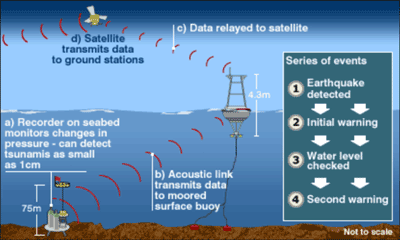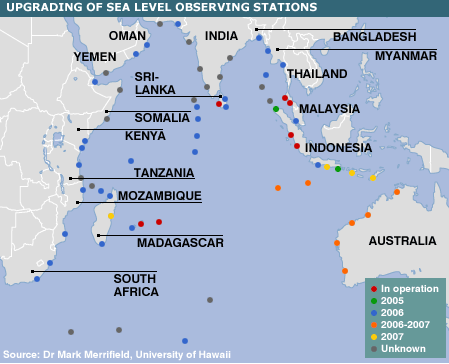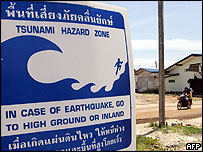DETECTING A TSUNAMI Other sea-based instruments are needed to help scientists decide if a tsunami has been triggered. These fall into two main types: pressure recorders in the deep ocean (see image above - source: bbc) and tide gauges monitoring sea-level at the coast. Germany is working on a joint project with Indonesia to put in place 10 of these buoys, the first two of which were installed in November 2005. India, Thailand and Australia are also planning to install Dart buoys along the Sunda Trench, the site of the earthquake that triggered the tsunami. The advantage of the Dart system is that it can detect tsunami far out to sea and give enough time to warn countries in the region. However, the buoys are expensive to install and maintain. Unesco's Intergovernmental Oceanographic Commission (IOC) is also focusing on a network of tide or sea-level gauges. Unlike Dart buoys, tide gauges in the Global Sea Level Observing System (GLOSS) are sited on land, either on mainland coasts or on islands out to sea. The most basic form of gauges monitor the surface of the water with a system of tubes and floats. More modern versions "ping" the surface of the water from above with radar or sonar; or use sea-bed pressure sensors attached to the sea-level observing station with a cable. Now, the stations are being upgraded so they can send real-time data via satellite to newly set up national tsunami centres and are being fitted with solar panels, to provide their own power source.
Twenty-three stations should be fully upgraded by the end of June 2006, according to the IOC, and more will follow in the next few years INFORMING THE PUBLIC: Governments of the 27 nations bordering the Indian Ocean have been setting up individual programmes for issuing tsunami alerts to their own people. However, they have been so far unable to agree which country or countries will host the regional alert centres to process international technical data and issue warnings across the area. Thailand, India and Indonesia are concentrating on their own systems and Australia, Malaysia and Singapore are planning to develop warning capacities. Thailand has opened a disaster warning centre which currently receives data from Hawaii and Japan. Alerts can be sent in minutes to national and local governments and the media. Thailand is also installing a network of 76 siren towers along part of its coastline and recently staged a tsunami simulation exercise for emergency services. India has also set up an alert centre which is monitoring data from seismographs and 11 tide gauges. Indian officials say a full system for the country should be in operation within two years. The UN is helping countries with other long-term measures including teaching tsunami awareness in schools, training decision-makers and broadcasters, and making sure information is available in all local languages and staging practice drills. The most recent meeting of the UN's Indian Ocean Tsunami Warning System group also recommended mapping coastal zones to work out which locations are most at risk of flooding and to which areas it would be safe to evacuate people in the event of an emergency. |


 Indonesia plans to spend $125m on setting up its own tsunami detection system.
Indonesia plans to spend $125m on setting up its own tsunami detection system.